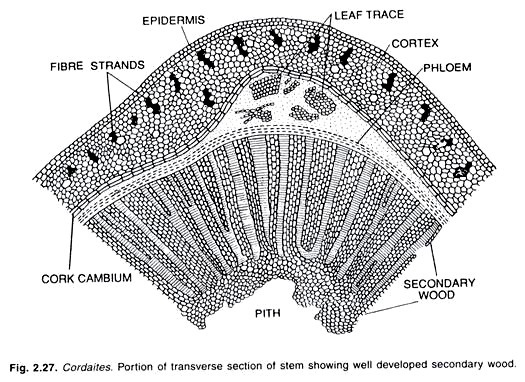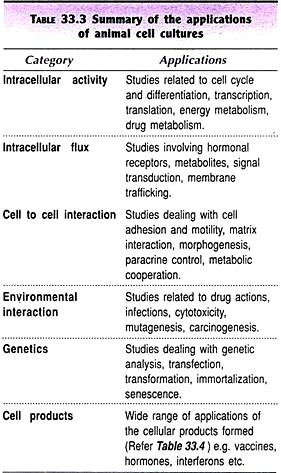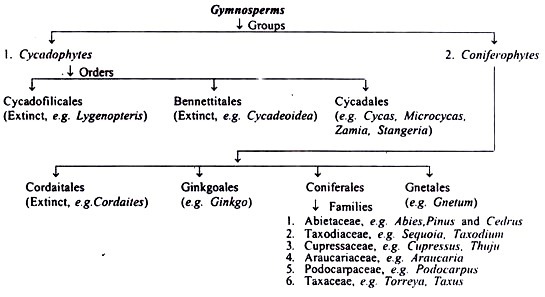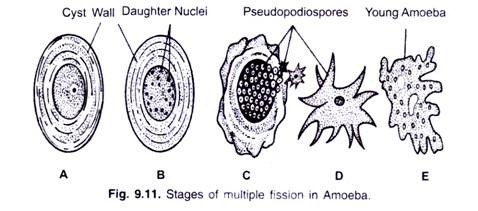Read this article to learn about the Structure and Life Cycle of Amoeba !
Systematic Position
Phylum: Protozoa
Class: Rhizopodea
Order: Amoebida
Genus: Amoeba
Species: proteus
Amoeba proteus is a unicellular organism widely distributed in ponds, lakes, freshwater pools and slow streams. Normally it is found creeping, feeding upon algae, bacteria etc. Under the microscope, it appears as irregular, jelly-like tiny mass of hyaline protoplasm. Amoeba has no fixed shape and the outline of body continues changing due to formation of small finger like outgrowths called pseudopodia (fig. 9.7). Pseudopodia are temporary finger like projections with blunt rounded tips which are constantly being given out or withdrawn by the body. Many pseudopodia are formed simultaneously. Amoeba exhibits movement by the pseudopodia. It also helps in food capture. Like an ordinary cell the body of amoeba has 3 main parts: Plasma lemma or plasma membrane, Cytoplasm and nucleus.
Pseudopodia are temporary finger like projections with blunt rounded tips which are constantly being given out or withdrawn by the body. Many pseudopodia are formed simultaneously. Amoeba exhibits movement by the pseudopodia. It also helps in food capture. Like an ordinary cell the body of amoeba has 3 main parts: Plasma lemma or plasma membrane, Cytoplasm and nucleus.
Plasma lemma is a very thin, delicate and elastic cell membrane of amoeba. It is composed of a double layer of lipid and protein molecules. This membrane is selectively permeable and regulates exchange of water, oxygen and carbon dioxide between the animal and the surrounding medium. From the outer surface of plasma lemma, small ridge like projections arise which helps in fixing the organism to the substratum.
The cytoplasm is differentiated into Ectoplasm and endoplasm. The ectoplasm forms the outer and relatively firm layer lying just beneath the plasma lemma. It is a thin, clear (non-granular) and hyaline layer It is thickened into a hyaline cap at the advancing end at the tips of pseudopodia.
The ectoplasm has a number of conspicuous longitudinal ridges. Due to the presence of longitudinal ridges in the ectoplasm, it is considered as a supporting layer. The endoplasm forms the main body mass completely surrounded by the ectoplasm. It is granular heterogeneous fluid. The endoplasm is made up of an outer, relatively stiff plasmagel and a more fluid inner plasmasol.
The plasmagel is granular and more solid but its granules show no movements. Besides granules, endoplasm contains a number of important inclusions such as nucleus, contractile vacuole, food vacuoles, mitochondria, Golgi apparatus, fat globules and plate- like or bi-pyramidal crystals. Endoplasm contains a number of organelles or structures suspended in it. These organelles are nucleus, contractile vacuole, food vacuoles and water globules.
Nucleus:
In Amoeba proteus, there is a single conspicuous nucleus. The nucleus appears as a biconcave disc in young specimens but it is often folded and convoluted in older specimens. The nucleus has a firm nuclear membrane or nuclear envelope and contains a clear achromatic substance with minute chromatin granules or chromidia distributed uniformly near the surface. The nucleoplasm is small in quantity. Such a nucleus is called massive or granular nucleus.
Contractile vacuole:
The outer part of the endoplasm near the posterior end contains a clear, rounded and pulsating vacuole filled with a watery fluid. This vacuole, called the contractile vacuole, is enclosed by a unit membrane.
Food vacuoles:
Numerous food vacuoles are scattered in the endoplasm. These are non- contractile and of different size. Each food vacuole contains a morsel of food under digestion. The food vacuoles are carried about by the movements of the endoplasm. Digestion of food takes place inside the food vacuole.
Water globules:
These are several small, spherical, colourless and non-contractile vacuoles filled with water.
Life cycle of Amoeba:
Reproduction in amoeba is a periodic process taking place at intervals. Reproduction in amoeba chiefly occurs by asexual method, i.e., by binary fission, multiple fission and sporulation.
(i) Binary fission:
It is the most common mode of reproduction. In this process, the whole body divides into two daughter amoebae by mitosis. The division involves nuclear division (karyokinesis) followed by division of cytoplasm (cytokinesis) (fig. 9.8). This takes place during favourable conditions.  (ii) Sporulation:
(ii) Sporulation:
Under un-favourable conditions amoeba reproduces by formation of spores internally. It starts with the breakdown of nuclear membrane and release of chromatin blocks into the cytoplasm. Each chromatin blocks acquires a nuclear membrane and becomes a small daughter nuclei. The newly formed nuclei get surrounded by cytoplasm to form amoebulae.
The peripheral cytoplasmic layer of amoebulae forms a tough and resistant spore-membrane or spore case (fig. 9.9). About 200 such spores are formed inside a single parent amoeba. Finally the body of parent amoeba disintegrates to release the spores. The spore remain inactive for some time and on getting favourable conditions each spore forms a young amoeba.
In un-favourable conditions, amoeba divides by multiple fission. It withdraws its pseudopodia, becomes spherical and secretes three layered cyst around itself. Its nucleus undergoes repeated mitosis division forming 500- 600 daughter nuclei. Each daughter nucei gets surrounded by mass of cytoplasm and divides into minute amoebulae. On getting favourable conditions the cyst ruptures to release the amoebulae which soon grows into adult amoeba (fig. 9.10-9.11).
Amoeba has tremendous power of regeneration. If it is cut into small pieces, each piece regenerates into a new amoeba, however, a piece without nuclear fragment does not regenerate.


